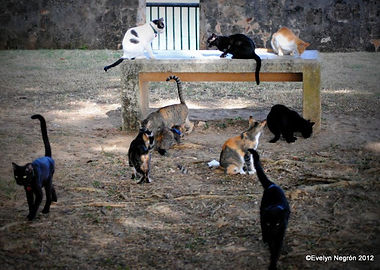


Trap, Neuter, and Return (TNR)
The ASPCA (American Society for the Prevention of Cruelty to Animals) points out that the method of Trap-Neuter-Return (TNR) is the only humane and effective way to manage cat colonies. Save a Gato has adopted this method to handle stray cats of Old San Juan. The information presented here describes how and why Save a Gato uses this method. Sadly, many communities still opt to control populations of cats using old methods like euthanasia. These methods are cruel and ineffective.
What is Trap-Neuter-Return (TNR)?
TNR is a method that consists of trapping, sterilizing, vaccinating, and returning feral cats to their colony in order to live healthy lives. Cats that are friendly and comfortable with humans enter our adoption program after being sterilized and vaccinated. SAG also needs volunteers who can care for these colonies, assisting with food and keeping an eye on the health of the cats. It is important to have all of the cat colonies sterilized in order to prevent any unwanted breeding of cats. TNR has proven to be the most efficient, humane, and lease expensive method in controlling the population of feral cats.
How does TNR benefit the community?
TNR helps the community by stabilizing the population of street cats and eventually reducing it. The benefit of natural control of rodents is continuous, but the bad behavior such as loud noises and fights are eliminated and no more kittens are born.
How does TNR help feral cats?
Through TNR, cats can live their lives without adding to the homeless cat population. After being spayed or neutered, cats living in colonies tend to gain weight and have a healthier life. Neutered cats are less likely to develop certain cancers, and neutered male cats also reduce the risk of injury and infection, because they have a lower instinct to fight with other cats. Spaying also means that cats do not go into heat and no other cats are attracted to the area. If cats are sterilized and live in a colony that has a caretaker, their quality of life and lifetime are improved because they have greater protection of space and food, and are less at risk for disease.
What is the clipping of the ear and why is it important?
The ear tag is a widely accepted means of marking a stray cat that has been spayed or neutered - also often identified as part of a colony of care. The ear tag is a humane surgical removal of 1/4 of the tip of the left ear. The procedure is performed by a licensed veterinarian, usually in the same operation when the cat is spayed or neutered. The ear tag is especially important since it prevents the stress the re-capture of an already spayed or neutered cat, and more importantly, an unnecessary surgery.
